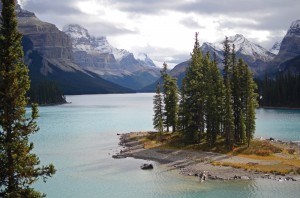
Parks Canada is proposing it decommission several of the Maligne Valley’s lesser-used backcountry campgrounds, in order to focus more of its funding and efforts on the Skyline and Jacques Lake trails.
The recommendation is just one of many outlined in the agency’s Oct. 5 discussion paper on the Maligne Valley Implementation Strategy.
The paper kicks off Parks’ second phase of public input on the strategy, which is meant to guide the agency’s work in the valley over the next five to 10 years.
Although many will look to the discussion paper for additional information on Maligne Tours’ proposed developments, the most substantive information it contains involves Parks’ plans for the wilderness areas scattered around the valley.
The section devoted to those areas explains that Parks will be refocusing funding over the next decade, stating the organization is “going to spend more money in some wilderness areas, and spend less in others.”
“Parks Canada is rationalizing its investments for all wilderness trails and facilities (e.g. wilderness campgrounds) so that it matches the level of service visitors have come to expect and what the agency can afford,” the report reads.
It goes on to claim that this will lead to better services at the most popular wilderness areas of the valley, such as the Skyline and Jacques Lake trails, and the trail network at the north end of the lake.
It does mean, however, that Parks will stop maintaining lesser-used trails, like Watchtower and Henry McLeod, which haven’t been cleared in years.
The report also proposes decommissioning several campgrounds, including Watchtower Campground, Evelyn Creek Campground and the Maligne Pass campgrounds (except Avalanche Campground).
Loni Klettl of the Jasper Trail Alliance said she is excited for the changes, because they will likely mean a better experience on the Skyline Trail, while still affording people the possibility of enjoying some of the no-longer-maintained campgrounds.
According to Klettl, the changes essentially mean that Parks will stop paying to maintain some of the lesser-used campgrounds, and invest instead in adding camping opportunities to the Skyline, making it accessible to more people over the course of the season.
“I’d rather have Parks focus on the trails they can maintain and that they can afford,” she said.
To keep the decommissioned campgrounds usable, she hopes the JTA will be allowed to come in and maintain the trails that Parks no longer will. This, she said, will allow those who want a more rugged backcountry experience another place to find it.
According to the report, these changes will also come with increased fees, “to better reflect the costs of servicing outhouses and maintaining access (subject to fee amendment and approval process).”
The Fitzhugh reached out to Parks for clarification on this and other statements in the discussion paper, but after agreeing to provide more information, Parks representative Kim Weir was unable to get approval to do so by press time.
Another major area identified in the paper is the drive to Maligne Lake. The report says Parks wants to make it “a more important part of the Maligne experience,” by encouraging visitors to stop along the way.
It intends to do this by providing basics like washrooms and parking in six key areas, as well as improving picnic facilties, creating some new short hikes and installing new interpretive panels. Parks also hopes to spruce up some of the viewpoints that have become overgrown in recent years, encouraging more leisurely travel along Maligne Lake Road.
Klettl was also on board with this change, commenting that Parks’ goal of making the Maligne Valley a more complete visitor experience feels like a step in the right direction.
“When you cross the Moberly Bridge, that’s where your whole Maligne experience begins,” she said, adding that better signage and sightline clearing should dramatically improve that experience.
Parks outlines many more possible changes in the 14-page discussion paper, including caribou herd augmentation, steps to make human activity more predictable for bears and ways to increase aboriginal participation in the future of the valley.
The final section, “Managing Growth and Development”, touches briefly on Maligne Tours’ development proposals, but offers no new information. It also proposes expanding the recycling program for day-use areas in the Maligne Valley, and restoring a wetland at Beaver Lake.
Parks is urging the public to read the report, and give feedback both at the Annual Public Forum, which was held Oct. 15, or by email. The deadline for feedback is Oct. 31.
According to Parks’ website, finalization of the implementation strategy is anticipated to start in the winter of this year. Parks will review the feedback it receives through its public engagement initiatives and aboriginal engagement consultations and prepare a final Maligne Valley Implementation Strategy for approval by the park superintendent.
It will make information about that final strategy available online by the spring of 2015.
Trevor Nichols
[email protected]
